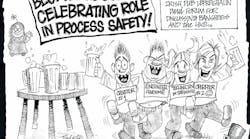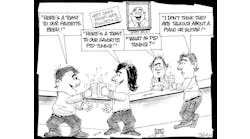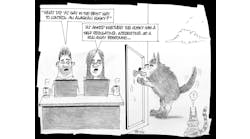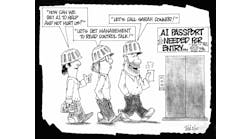This is part three of a series with Michael Taube. Read part one here and part two here.
Greg: We continue this series of discussions with Michael Taube, principal consultant at S&D Consulting in Houston, to gain insights and critical details for making improvements in process safety, which can address the issue of the plateaued total recordable incident rate (TRIR).
Michael, given all that we’ve covered in our last article, what’s the starting point for pursuing the “new view” of safety?
Michael: There’s considerable published research and reviews of high-reliability organizations (HROs)that the process industries should emulate. HROs invest in people first. They recognize that safety (personnel, process and environment) depends heavily on individuals creating safe outcomes by asking the right questions. HROs understand operators, maintainers and supervisors (the ones at the sharp end of the process) create safety by making observations with a purpose—looking for abnormal or deficient conditions. To do it successfully, people must be knowledgeable, competent and proficient, and know what “right” looks like. Investments are made in front-line workers and supervisors with heavy emphasis on the technical fundamentals specific to the hazards of their processes.
Two HROs, commercial aviation and the U.S. Dept. of Energy’s Naval Nuclear Propulsion Program (NNPP), provide strong examples. They both conduct intensive and realistic training for those at the sharp end, emphasizing abnormal condition responses. Appropriate operator response becomes ingrained—they’ve seen each situation (or something similar) before and know what to do. As stated by retired U.S. Navy submarine commanders Bob Koonce and Matthew DiGeronimo, in their book, Extreme operational excellence: applying the U.S. nuclear submarine culture to your organization (Sandman Books 2016, bit.ly/ExtremeOperationalExcellence), “The cumulative impact of each member of the organization learning to think critically about what they’re doing at any given time provides massive returns on the investment spent in developing those critical thinking skills.”
Adm. H. G. Rickover, often called the “father of the nuclear navy,” held several core principles. One was “defense in depth,” which wasn’t only about physical layers of protection, but also about the knowledge of those doing the work. His philosophy was that systems can never replace the ability, capability, foresight and insight of a qualified and experienced human. Many safety approaches are rife with holes and gaps because they can’t anticipate every possible scenario. The failures of these systems come down to people. Too few are experienced and too few are trained and qualified. As Koonce and DiGeronimo write, “Thoughtful and knowledgeable operators recognize when systems are operating outside the parameters that the procedures assume.”
Greg: What else do HROs do that makes them successful?
Michael: We also previously touched on hiring practices. HROs take a different approach to hiring. Getting into the program is easy, but staying requires work. HROs don’t look for the perfect fit or to hire only the best. While they have certain minimum entry criteria, the real emphasis is on finding people who will put in the effort to gain knowledge and understanding regardless of abilities, talents or skills. They eliminate those unwilling to put in the work. Thus, the process industries must stop searching for unicorns, and retool their recruiting philosophy to find people with potential and train them.
Greg: What other areas must be addressed?
Michael: The dominant business philosophy of today is still “Theory X” described by social psychologist Douglas McGregor in the 1960s. Management assumes that workers are too lazy, unmotivated and uncaring to take action, or alter their behaviors to achieve the business’ objectives, and that they respond only to monetary incentives. Research shows that monetary incentives are poor motivators for affecting business and safety outcomes. Yet, process industry management continues to use this theory to affect safety. This approach is further compounded by the concept of shareholder value, which compels management to reduce headcounts and cut investment in workers. This is, of course, the very antithesis of HRO practices.
Research also demonstrates that people respond far more enthusiastically and effectively to intrinsic motivations—being part of a worthy cause, recognized for good work or being part of a high-performing team—rather than purely extrinsic ones such as money. Management must ask why is this company (or industry) is worthy of someone’s time and energy? If the answer has anything to do with money, including retirement benefits, healthcare, etc., then they’ve missed the mark.
This is often overlooked when considering what makes HROs successful. It’s not about the money. It’s about belonging to something bigger than oneself. People want to be part of an organization that’s recognized for its excellence.
Greg: What are the biggest hurdles that process industry management must overcome to become an HRO?
Michael: The first step is to admit what you are, which requires an honest self-assessment to recognize what assumptions one has and why. Then, one must challenge those assumptions and validate them objectively. Objectivity is the big challenge since we’re all victims of cognitive, cultural and educational biases. Consequently, we must make a concerted effort to recognize and overcome these biases.
One of the biggest biases is that other people are the problem. This bias relieves us of responsibility, but all problems are leadership problems. Before one can lead others, one must lead oneself. So, to address the problems, challenges and frustrations one encounters, one must first take responsibility for oneself and what one does and doesn’t do. Hence, the requirement for a serious self-assessment.
This is why process industry management must first take responsibility for its choices and decisions, including those of its predecessors. This is where real leadership reveals itself. The continued promulgation of “do more with less” has decimated the boots on the ground, and quality and improvements will continue to suffer until this philosophy is reversed.
Greg: What other paradigm shifts are needed for the process industries to see safety improvements?
Michael: Herb Kelleher, co-founder of Southwest Airlines, once said, “Our business is people. We just happen to fly airplanes.” It was this mindset that made Southwest Airlines successful. The process industries, on the other hand, takes the position that “the business of business is business,” which sees people as costs to minimize and pursues short-term profit objectives over long-term business sustainment. Ironically, the culture Kelleher created has been slowly eroded by this same attitude. We also see similar attitudes being revealed by Boeing’s management, and the inexorable outcomes now coming into public view.
The base of organizational pyramid has eroded, and the structure above is crushing what little foundation remains. The process industries must rebuild their foundation—people. Specifically, these are people who do the work that makes the business productive, such as operators, engineers and craft labor (construction and maintenance). Until concerted, consistent and committed investment is made to rebuild the foundation, we’ll continue to witness unprecedented and unpredictable safety events, though they’ll be viewed as quite predictable after the fact.
The challenge is that process industry management is unlikely to recognize the error of its ways. As Sidney Dekker, an Australian professor and noted author on safety topics, said, “It’s extremely difficult for people to renounce the paradigm that led them into a crisis.” Regarding the situation at Boeing and other businesses, “It’s become clear that Boeing’s problems run far deeper. They expose decades of American corporate philosophy gone awry…The people at the top are there to maximize shareholder value…It’s so ingrained in their thinking they don’t understand the problem itself…It’s also questionable whether other major companies with a similar maximize-shareholder-value-at-all-costs ethos will learn from these mistakes.”
Greg: The presence, knowledge, competence and openness of operators, process engineers, modeling and control specialists, and automation and maintenance professionals will always be essential to process safety and performance. The “lights out” control room envisioned during the birth of the distributed control system (DCS) never materialized, and as far as I can see, never will. Similarly, the advent of artificial intelligence (AI) will not eliminate the need for humans. We should realize that new technologies don’t eliminate but elevate the role of humans. Better instrumentation, modeling and control can lead to tighter process control and greater process understanding that frees up and enables higher levels of participation by humans.
Process control provides more repeatable responses assuming good tuning, measurements and final control elements (e.g., control valves) that enables greater concentration on what’s happening in the process and takes into account loop dynamics and dead time. Variability is transferred from controlled variables to the manipulated variables (e.g., flows). While human actions aren’t very repeatable, varying considerably from person to person, they are creative and can think outside the box. Control systems can learn, but creativity is limited by the technology box. We’ve greatly benefited from elevating the human role by using tighter and smarter process control, which helps the system stay away from unsafe conditions despite changes in operating conditions. We can use override control and optimizers to achieve better operating conditions, procedure automation to handle startups, transitions and shutdowns, and state-based control to deal with abnormal equipment conditions.
Digital-twin, dynamic, first-principle simulations that include overlooked final control element dynamics are the best way to gain, improve and sustain knowledge to advance system and human performance. Operators, process engineers, modeling and control specialists, and automation and maintenance professionals should all have monthly training sessions and continual access to experimentation and testing. Dynamic simulation, cause-and-effect knowledge is the key to better process understanding and can be used to improve data analytics by eliminating confusing auto correlations and cross-correlations. The dynamic simulation can be adapted to better match plant operations by having an online digital twin run in sync with the plant, whose controllers have the same setpoints and tuning. A model-predictive controller (MPC) can be set up and developed non-intrusively offline, and adapt dynamic-model parameters, so an online digital twin’s controller outputs better match the plant’s controller outputs.
As a side note, my last dialog, cartoon description, and Top 10 list were written on Earth Day sitting under 100-year-old live oak trees listening to Santana’s “Supernatural” and Smashing Pumpkins’ greatest hits.





